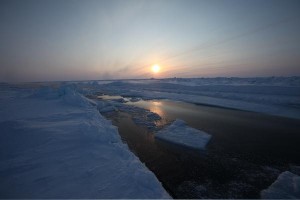You can tell a “wet” or open lead from a frozen one for the discoloration on the ice at the water’s edge. A wet lead has a brownish hue which noticeably breaks from the duotone spectrum of white and blue of the Arctic ice. From an ice mound even just a couple of feet high, you can spot a large open lead from a distance; and invariably, tension sets into the pit of your stomach. An open leads means business: it will generally cut your route (for obvious reasons you are more likely to run into an east/west lead when traveling north), and challenge you for a strategy to bypass it. Often, this will involve a calculated risk. At best, a wet lead will cost you time; at worst it will kill you. We crossed so many open leads today (the strong winds of the last few days have surely helped put more cracks in the ice) that I lost count. Sivce the sea ice feels and looks like a desert, it’s a always a mind twisterr to acknowledge that leads are not canals or rivers: they immediately drop to the ocean’s floor; and that below your feet, the ice is just a few feet thick floating above the same great depth!
After being robbed of two miles ovenight to the south drift, we set off onto broken-up terrain, which slowed us down. Route finding and lead crossing strategy are some of the fundementals of North Pole travel. And today, we had plenty of opportunity for both. The weather was not bad to start at minus 22F, sunny and a light 5mph breeze. You always get an elated sense of relief and satisfaction when you beat the challenge of an open lead. Sometimes you “trick” it, sometimes you luck out; other times you work hard at it. But when nature does the work for you, that is undoubtedly one of the greatest shows on Earth. By afternoon, we got trapped in a mangled maze of twisted and fragmented cracks system, spread over a couple of miles. But unlike the seemingly still, icy world which we have mainly been privy to, today–like yesterday–displayed the enormous power that lurks the sea. Upon approaching a massive open lead, we spotted what seemed like a pinch crowded with ice blocks. In fact, those blocks–some weightiing multiple tons–were being shoved around like rubber duckies and pressed into a 20 foot pressure ridge right before our eyes. A spectacle of sound and sights of incredible proportion which not many people get to see!
Due in part to the abundance of open water, we were soon shrouded in a thick ice fog. And over the course of the day, the winds grew again to 25-35 mph strong with visibility reduced to a couple of hundred feet. Ice fogs, as you’d expect from the name, are not warm. Temperature dropped to -27F and high humidity which makes it feel 10 degrees lower. Between the terrain and the conditions, travel became increasingly difficult. Additionally, the snow drift from the wind covered many of the small wet leads making them blend in and seem frozen–a challenge when you’re in the lead.
We are also now constantly thinking about food, as it is now clear that we have to ration or we will run out, and it is affecting our psyche. We traveled for 12.5 hours and only covered 10 nautical miles–probably two more factoring drift. We are still flying east and our position upon stopping was N88°15.115 and W58°13.915. Today was tough. We hope for better conditions tomorrow… Thank you for keeping with us.


